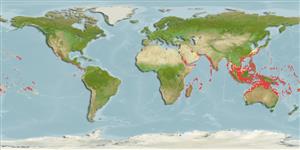Malacostraca |
Decapoda |
Xanthidae
Environment: milieu / climate zone / εύρος βάθους / distribution range
Οικολογία
Υφαλόφιλο(α); εύρος βάθους 0 - 95 m (Αναφ. 96667). Tropical
Indo-Pacific: South Africa to Hawaii.
Length at first maturity / Μέγεθος / Weight / Age
Γεννητική Ωρίμανση: Lm ? range ? - ? cm Max length : 8.0 cm CW αρσενικό/απροσδιόριστο; (Αναφ. 343)
Carapace distinctly broader than long, surfaces very smooth; anterolateral margin with 5 lobiform teeth (first 2 teeth never spine-tipped). Chelae very long in adults, reaching or almost reaching maximum width of carapace. Color: quite variable, from dark grey to reddish brown, often with a patchwork of grey and dark brown. One of the most distinctive memebers of the genus because of its very broad and smooth carapace with lobiform anterolateral margins, and the elongate chelipeds.
Occurs from the intertidal zone to a depth of about 20 m (Ref. 343). Subtidal on rocky areas (Ref. 801). Inhabits reefs especially on disturbed reef flats (Ref. 343) or in areas exposed to currents (Ref. 801). Found between crevices or under rock fragments (Ref. 132434).
Life cycle and mating behavior
Γεννητική Ωρίμανση | Αναπαραγωγή | Γεννοβολία | Eggs | Γονιμότητα | Larvae
Members of the order Decapoda are mostly gonochoric. Mating behavior: Precopulatory courtship ritual is common (through olfactory and tactile cues); usually indirect sperm transfer.
Ng, P.K.L. 1998 Crabs. p. 1045-1155. In K.E. Carpenter and V.H. Niem (eds) FAO species identification guide for fishery purposes. The living marine resources of the Western Central Pacific. Volume 2. Cephalopods, crustaceans, holothurians and sharks. Rome, FAO. 1998. pp. 687-1396. (Αναφ. 343)
IUCN Red List Status
(Αναφ. 130435: Version 2025-1)
CITES status (Αναφ. 108899)
Not Evaluated
Not Evaluated
Threat to humans
Human uses
| FishSource |
Εργαλεία
Περισσότερες πληροφορίες
Τροφική ΟικολογίαFood items (preys)
Σύσταση δίαιτας
Κατανάλωση τροφής
Θηρευτές
Population dynamicsΑύξηση
Max. ages / sizes
Length-weight rel.
Length-length rel.
Length-frequencies
Mass conversion
Αφθονία
Life cycleΑναπαραγωγήΓεννητική ΩρίμανσηΓονιμότηταΓεννοβολίαEggsEgg developmentLarvae PhysiologyΚατανάλωση οξυγόνου
Human RelatedStamps, coins, misc.
Διαδικτυακές πηγές
Estimates based on models
Preferred temperature
(Ref.
115969): 24.5 - 29.1, mean 28 (based on 1756 cells).
Fishing Vulnerability
Low vulnerability (10 of 100).
Price category
Unknown.
